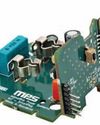"MRAM CAN KEEP DATA Even When Power Is Off!"
Electronics For You
|November 2024
What is MRAM, and what makes it special? EFY's Nidhi Agarwal sat down with Sanjeev Aggarwal, President & CEO, Everspin to uncover the answers...
-

How does MRAM work?
MRAM (magnetoresistive random access memory) operates by using two magnetic layers separated by an insulating layer. These layers can align in the same or opposite directions, altering the resistance and allowing the memory to store data as 0s and 1s. MRAM is fast, enabling data to be read and written in about 35 nanoseconds. It supports frequent writing without degradation. Additionally, it retains data when powered off and functions across a wide range of temperatures.
How is MRAM different from other non-volatile memories?
Compared to other memory types, such as battery-backed SRAM, MRAM has distinct advantages. If the SRAM battery fails, all data is lost, and its read and write capabilities are limited. In contrast, Everspin MRAM is persistent and supports unlimited read and write cycles. Ferroelectric memory, another option, performs well at low voltages but can face reliability issues at high temperatures. MRAM, however, operates reliably across a broad temperature range, preserving data safely even during unexpected power failures.
How are the two types of MRAM different?
Toggle MRAM and spin-transfer torque (STT) MRAM are distinct in their operation. In toggle MRAM, a magnetic field switches the direction of the top magnetic layer, known as the free layer, while the bottom layer remains fixed. For STT MRAM, the direction is altered by passing a current through an insulating layer between the two magnetic layers.
Toggle MRAM cannot be miniaturised extensively due to the size required to generate the magnetic field for switching. It is available in sizes ranging from 128 kilobits to 16 megabits. STT MRAM, on the other hand, can be scaled smaller with technological advancements, is available in sizes from 16 megabits to 128 megabits, and even up to 1 gigabit, making it suitable for replacing traditional RAM.
This story is from the November 2024 edition of Electronics For You.
Subscribe to Magzter GOLD to access thousands of curated premium stories, and 10,000+ magazines and newspapers.
Already a subscriber? Sign In
MORE STORIES FROM Electronics For You

Electronics For You
Tech Majors Are Racing TOWARDS NET-ZERO - What About You?
Apple, Microsoft, Amazon, Google, Infosys, Wipro—global and Indian firms are heading closer to achieving net-zero emissions, a mandate to combat climate change. Here is what you need to know to start your journey...
12 mins
December 2025

Electronics For You
Miniature IoT WATER TDS And LEVEL MONITOR Cum CONTROLLER
For setups that rely on stored water, clear awareness of tank level and water quality is essential.
3 mins
December 2025

Electronics For You
The Impact Of GENERATIVE AI On The Future Of AUTOMOTIVE AND EVs
Autonomous vehicles, connected ecosystems, and smart factories are only the beginning. Generative Al is pushing the auto industry beyond predictions into a bold era of creativity-from EV design to real-time diagnostics and showroom automation. Here is how GenAl is reshaping innovation across the automotive value chain.
8 mins
December 2025

Electronics For You
How AI Tools Are Making SOFTWARE DEVELOPMENT BETTER
AI is reshaping how we code, debug, and collaborate. From Copilot to automation, it is changing software development in ways worth exploring.
3 mins
December 2025
Electronics For You
How AI Tools Are Making SOFTWARE DEVELOPMENT BETTER
AI is reshaping how we code, debug, and collaborate. From Copilot to automation, it is changing software development in ways worth exploring.
3 mins
December 2025

Electronics For You
5 Interesting Reference Designs FOR SMART HOMES
Smart home devices are transforming the way people interact with their appliances. They make homes more convenient, secure, and energy-efficient. From smart plugs and energy monitors to smart locks and thermostats, reference designs help design engineers create connected products that are easy to use, consume less power, and are reliable. These designs allow you to control devices remotely, track energy use, extend battery life, and automate routines. They provide practical solutions for upgrading homes and small commercial spaces without major modifications.
3 mins
December 2025

Electronics For You
Fancy USB LED VASE
This USB LED vase is a simple yet elegant device that fuses art with electronics to create a decorative lighting display. Powered directly from a standard USB port, it uses readily available components such as MOSFETs, resistors, capacitors, and LEDs to produce a striking, dynamic sequence of lights.
3 mins
December 2025

Electronics For You
"WHAT OTHERS SELL IN FOUR BOXES WE BUILT IN ONE"
Years of custom field work are shaping a product line with its own cloud, its own hardware, and a market that is now beginning to recognise its value.
8 mins
December 2025

Electronics For You
BUILD LARGE LANGUAGE MODELS
Large language models are machine learning models designed for a range of language-related tasks such as text generation and translation. Here’s how open source software can help you build your own large language model.
6 mins
December 2025

Electronics For You
Rare Earth Or Rare Ingenuity? India Remains Between The Two
With China firmly controlling rare earth exports, India confronts a critical moment in its technological trajectory.
8 mins
December 2025
Listen
Translate
Change font size

